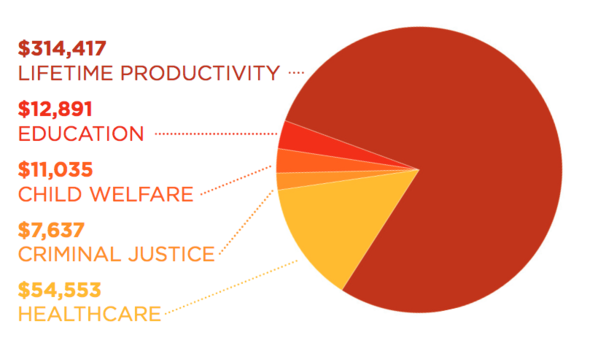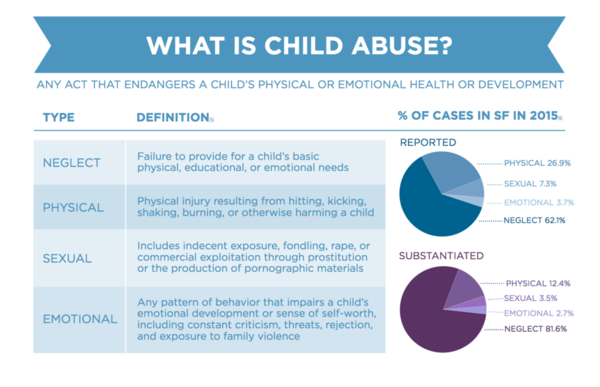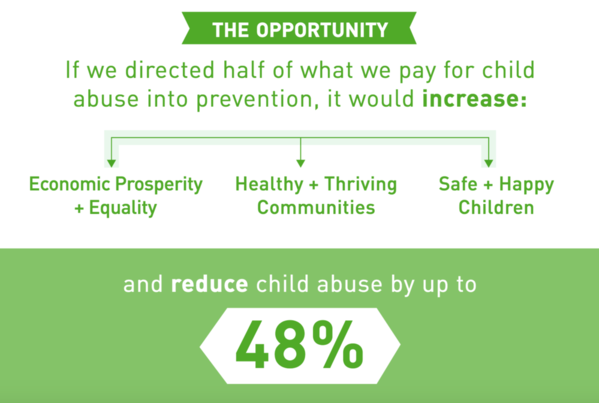In 2015, 5,545 children in San Francisco, CA, were reported to have experienced abuse. Of those, the reports of 753 children were substantiated. The expense to San Francisco for not preventing that abuse will cost $400,533 per child over his or her lifetime. That adds up to $301.6 million for just that one year, according to “The Economics of Child Abuse: A Study of San Francisco.”
And, because child abuse is profoundly underreported, the costs are likely to be as much as $5.6 billion/year, the report found.
The report, released today, provides the first calculation of the economic burden of child abuse in San Francisco. It was put together by the San Francisco Child Abuse Prevention Center and the Social Sector Solutions program at the Haas School of Business at the University of California, Berkeley. The HAND Foundation contributed to the effort.
“Although we have quantified the cost of a child abuse victim, it’s impossible to quantify the impact of abuse to a child, their family and our community -- with one single case our society has been degraded,” said Katie Albright, executive director of the San Francisco Child Abuse Prevention Center. “This report proves that not only morally, but fiscally, it is our mandate as a community to end child abuse once and for all.”
The report echoes other economic analyses. Let’s look at only the children who were abused in the U.S. in 2008. Add up the total lifetime economic burden resulting from their maltreatment. It’s a whopping $124 billion. Include all the people who were abused each year even for just 10 years, and the number begins rolling into the trillions.
The CDC’s National Center for Injury Prevention and Control, which did those calculations, broke down that unfathomably large number into this:
The lifetime cost for one child who was a victim of maltreatment is $210,012 in 2010 dollars. This includes:
- $32,648 in childhood health care costs;
- $10,530 in adult medical costs;
- $144,360 in productivity losses;
- $7,728 in child welfare costs;
- $6,747 in criminal justice costs;
- $7,999 in special education costs.
In San Francisco, the costs (in current dollars) are:
- $54,553 in health care costs (child and adult);
- $314,417 in lifetime productivity losses;
- $11,035 in child welfare costs;
- $7,637 in criminal justice costs;
- $12,891 in education costs
 The economic costs are extremely conservative, the report noted, for three reasons:
The economic costs are extremely conservative, the report noted, for three reasons:
- A large number of reported cases of child abuse can’t be investigated, don’t have enough evidence, or don’t meet “the threshold of severity to warrant official action”, according to the report, but still result in the child being traumatized, which can result in more costs. The costs associated with unsubstantiated child abuse can amount to $2.2 billion, according to the report.
- Child abuse is woefully underreported. According to the report, an estimated 11.5 percent of San Francisco’s children experience abuse each year. The $300 million figure in the report accounts for the costs of abuse for only one-half of one percent of the city’s children.
- Unquantified costs – such as how childhood adversity can lead to homelessness, family violence, divorce, shortened lifespan, and children who grow up to abuse their own children – are the most difficult to estimate, but the report set the economic consequences at $5.6 billion.
As part of its economic message, the report also points out that if half of the money spent on the consequences of child abuse were spent on prevention, child abuse could be reduced by 48%.
The report defines child abuse as physical, sexual and emotional abuse, and physical neglect. However, that definition is only what child protective service agencies will investigate.
The ground-breaking CDC-Kaiser Permanente Adverse Childhood Experiences (ACE) Study looked at an additional six, including living with a family member who’s addicted to alcohol or other substances, losing a parent to divorce or separation, living with a family member who’s depressed or has other mental illness, having a family member who's incarcerated, and witnessing a mother being abused. Other subsequent ACE surveys include racism, witnessing violence outside the home, bullying, living in an unsafe neighborhood, and involvement with the foster care system. Other types of childhood adversity can also include being homeless, living in a war zone, being an immigrant, moving many times, witnessing a sibling being abused, witnessing a father or other caregiver being abused, involvement with the criminal justice system, attending a zero-tolerance school, etc.

The ACE Study found that the higher the ACE score – the more types of childhood adversity a person experienced – the higher the risk of chronic disease, including mental illness, and violence and being a victim of violence. The study found that most people (64%) have an ACE score of one; 12% of the population has an ACE score of 4. Having an ACE score of 4 markedly increases the risk of chronic disease: It nearly doubles the risk of heart disease and cancer, it increases the likelihood of becoming an alcoholic by 700 percent, and the risk of attempted suicide by 1200 percent. (For more information, go to ACEs Science 101. To calculate your ACE and resilience scores, go to: Got Your ACE Score?)
How this relates to the report issued today is that the ACE Study found that it didn’t matter what the types of ACEs were. An ACE score of 4 that included divorce, physical abuse, an incarcerated family member and a depressed family member had the same statistical health consequences as an ACE score of 4 that included living with an alcoholic, verbal abuse, emotional neglect and physical neglect.
In the San Francisco Bay Area, there are 58,000 reported cases of child abuse each year, noted the report. That’s one every 10 minutes.
When hearing about child abuse, many people immediately point the finger at parents, but research clearly shows that a child can only be healthy in a healthy family, and a family can only be healthy in a healthy community. San Francisco has a lot of problems and policies that make the environment very unhealthy for families and children, including policies that allow an overabundance of alcohol outlets; policies that don’t provide enough safe housing for people; policies that ignore the need for more employment at a living wage; a rapid increase in housing costs that have resulted in more people who are homeless, including their 3,222 children, a number that’s nearly doubled since 2007; unsafe neighborhoods; and families with children leaving San Francisco because of housing costs, unsafe neighborhoods and schools, which weakens the social networks that families need to thrive.
San Francisco is part of state and national movement to integrate trauma-informed and resilience-building practices based on new knowledge about ACEs science that provides a new understanding of human behavior; how to change human behavior, whether it’s criminal behavior, unhealthy behavior or unwanted behavior; and how to change organizations, businesses, systems and communities to become healthier places.
The good news is that many people and organizations are working to reduce childhood adversity in the city. The San Francisco Child Abuse Prevention Center, San Francisco Department of Public Health, the San Francisco Unified School District, First Five San Francisco, the Department of Children, Youth and Their Families and the Human Services Agency of San Francisco, the Federal Reserve of San Francisco, the Center for Youth Wellness, the YMCA and many other organizations and funders are all working on aspects of improving the community to make it a healthier place for families, and of educating parents about how to integrate supportive factors to increase their own health and the health of their children.
Here are links to the full report, a summary, and an infographic.





Comments (0)